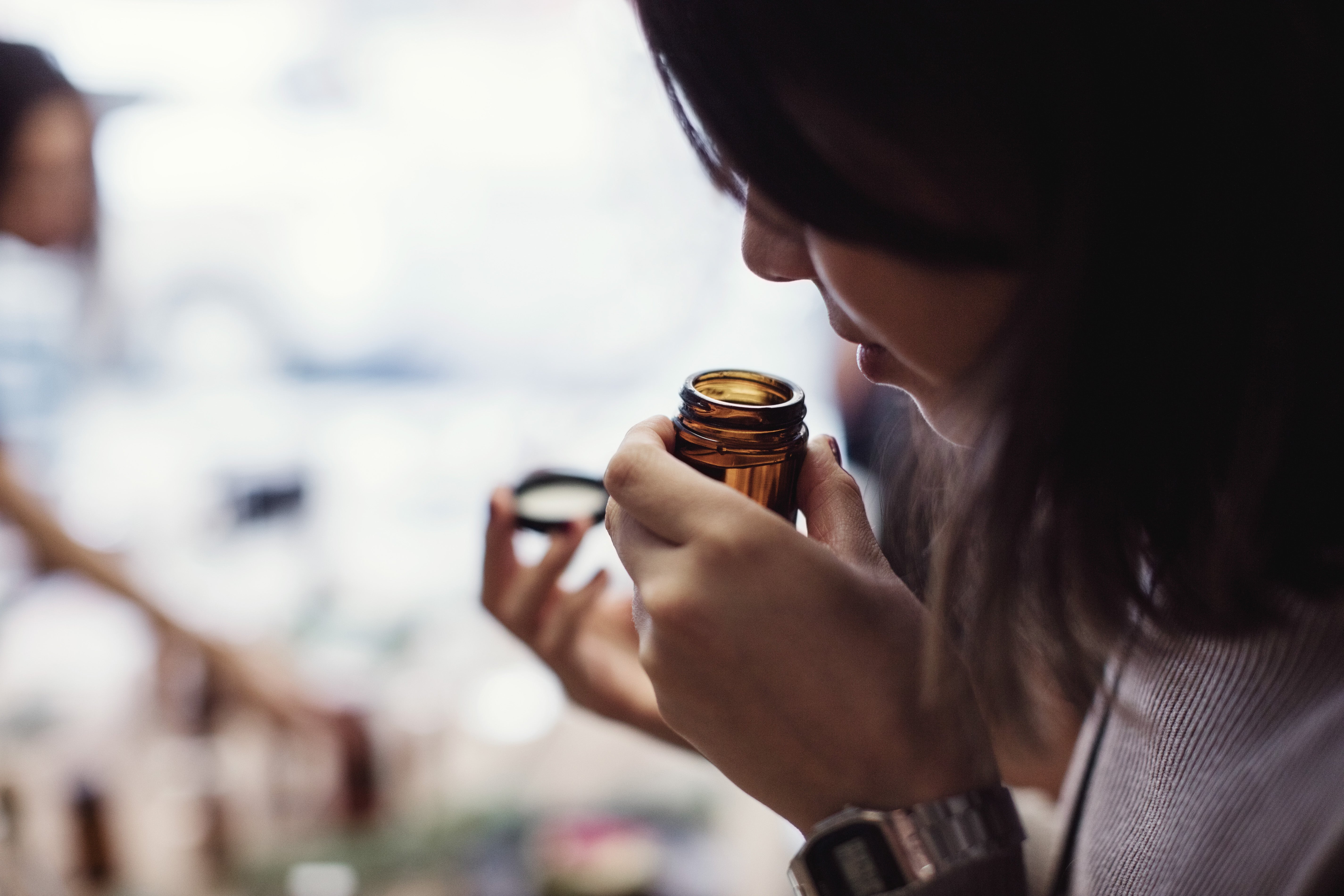
I was in the third grade when I realized I couldn’t smell. My class was on a field trip to a wastewater treatment plant and while everyone around me was disgusted by the stench, I had no problem with it whatsoever. I had anosmia, the loss or impairment of the ability to smell. Many doctor visits later I discovered why. Rather than acquiring anosmia through a virus or traumatic injury, I was likely born without fully formed olfactory bulbs—a condition known as congenital anosmia.
Estimates vary, but according to the National Institutes of Health, nearly one in four Americans older than age 40 report having some alteration in their sense of smell––and that statistic represents only the people who have noticed it. Anosmia has entered mainstream consciousness in recent years, thanks in large part to the COVID pandemic. Many people who have tested positive for COVID have experienced smell loss––and a recent BMJ study shows that 5 percent report persistent smell or taste dysfunction six months after infection. Yet smell disorders afflicted countless people prior to March 2020.
“As COVID hit, and the loss of smell and taste became more widely known as part of that…, many more people have become aware of how impactful that can be on your life overall,” says Zara Patel, a smell disorder expert at Stanford University.
Throughout the past few years, there have been a number of research efforts supported by the National Institutes of Health’s Rapid Acceleration of Diagnostics Radical (RADx-rad) program to develop smell tests that could be used in the context of COVID-induced anosmia. These tests can be an effective tracking tool for the onset of COVID. Many researchers believe they could––and should––be repurposed for more widespread use, however.
Smell is a sentinel for several medical conditions. Olfactory loss is one of the initial symptoms of neurodegenerative diseases such as Parkinson’s and Alzheimer’s. Smell loss can also influence an individual’s nutrition, mental health and general safety. Experts argue that being able to screen for smell dysfunction early on can improve health outcomes.
“The pandemic highlighted this gap in smell testing where we don’t have a test that can be really rapidly distributed throughout the population to screen for diseases where smell loss is a symptom,” says Stephanie Hunter, a postdoctoral fellow at Monell Chemical Senses Center, who was involved with the development of one such test. “But it’s also helpful after the pandemic.”
Although smell tests existed long before the pandemic, they are not widespread in routine medical care. A recent review of all available clinical olfactory knowledge, co-authored by Patel, chronicles more than 100 different kinds of assays used across the world, including the NIH Toolbox Odor Identification Test, the University of Pennsylvania Smell Identification Test (UPSIT) and the Sniffin’ Sticks tests. There are odor identification tests, discrimination tests (where individuals are asked to tell the difference between smells) and threshold tests (which determine the minimum concentration of a chemical that subjects can detect).
A little more than a quarter of these tests are commercially available. And most of the time, doctors don’t proactively administer them.
During the winter of 2008–2009, Katie Boateng became sick with an upper respiratory tract infection. Her symptoms seemed normal, but when her roommate started spraying bleach one day, Boateng, now a founding member and current president of the Smell and Taste Association of North America (STANA), realized she had lost her sense of smell. Boateng consulted multiple doctors in an attempt to figure out why she couldn’t smell, but after they ruled out the presence of a brain tumor she was left to her own devices. She was never once administered a smell test, she says.
“I think it’s important to have universal chemosensory testing for people so that we know what their baseline is,” Boateng says. “That way, when they go to a doctor and present with an issue, there’s something to judge it against.”
Toward a Universal Smell Test
STANA and many different chemosensory researchers and advocates are pushing for a widespread smell test––something that would be as easy to administer as a hearing or vision test.
SCENTinel, a test developed by researchers at the Monell Center, including Hunter and its assistant director Valentina Parma, and supported by the RADx initiative, could be a quick and cheap alternative to current methods. This multifunctional test is a card with a QR code that subjects scan to answer four questions that evaluate odor detection, intensity, identification and pleasantness. As demonstrated in a study published in February in Chemical Senses, the test is able to discriminate accurately between several different olfactory disorders.
The RADx initiative has funded a number of other smell test projects. There’s ArOMa-T, an olfactory threshold test developed by researchers at the University of Florida Center for Smell and Taste that consists of a card with 17 different odor-containing panels and an accompanying smartphone app. Separately, researchers at Ohio State University have been testing how candy can be used to detect chemosensory loss.
Patel is also developing her own smell test at Stanford that she describes as an electrical recording and stimulation device for the brain. Rather than asking a subject to self-report, the device would get a signal directly from the neurons themselves. “That, in my mind, is a better smell test, as it removes subjectivity, cultural bias, language bias, literacy bias, and cognitive bias and is thus a complete change in the way we think about smell testing,” she says.
The researchers I spoke with believe their tests could be easily integrated into doctor’s offices. But there are challenges to implementation and a number of reasons such smell testing isn’t already common clinical practice. The most technical reason, many experts say, is that the infrastructure doesn’t exist yet. Currently, smell tests aren’t covered by insurance and don’t even have a code for doctors to use for diagnosis or insurance reimbursement as blood tests or other assays do.
“The groundwork really hasn’t been done to prove that testing your sense of smell is, from a health economics perspective, the right move,” says Patricia Lucas-Schnarre, CEO of Ahersla Health, a company involved with the commercialization of SCENTinel. She adds that it will take some back-and-forth with the U.S. Preventive Services Taskforce, a panel of experts that provide recommendations for clinical preventive services, to convince the panel that it’s worth administering these tests regularly and that insurance companies should cover them.
This would include demonstrating how smell testing would improve individual health. One of the major criticisms of smell testing is the fact that there isn’t always a clear next step for treatment.
“It’s not like you get a score on this test and it means this or the next step in terms of therapy is that,” Parma explains. “This is just one piece of a much larger … and complicated puzzle, but my argument is that it’s a piece we want to include.”
Earlier Diagnosis and Treatments
Some treatments for smell loss have shown some promise. Olfactory training, which consists of daily and repeated exposure to odors, is the most well studied. But doctors are also experimenting with other treatments such as topical steroids or omega-3 supplements. There are also efforts to build neuroprostheses that would help people with anosmia detect smell again.
And although treatments would likely be useless for people with congenital anosmia, there are things to be aware of if you live a life without smell.
“Sometimes there aren’t treatments that are relevant, but we do make sure to provide patients with a variety of information about safety,” says Steven Munger, director of the University of Florida Center for Smell and Taste and co-creator of the ArOMa-T test. For example, “if you have natural gas in your home, get a detector.”
The Monell Center, STANA and many other organizations are currently planning a conference to bring together scientists, clinicians, public health officials and people with smell and taste disorders to further workshop how to make universal chemosensory testing a reality. Boateng says it’s even harder to develop taste tests, but these are just as important and deserve attention.
“We’re working toward a world where smell and taste are valued as essential to someone’s safety, health and well-being,” Boateng says. “That’s what we want, and a part of that is smell testing.”


